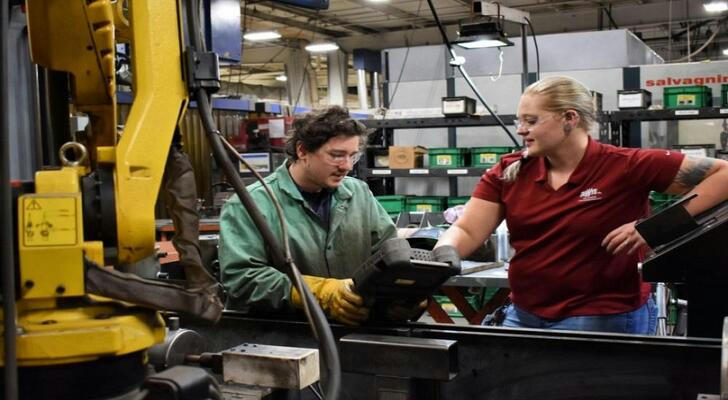How To Make $68,000 In The Metal Industry With Zero Experience
【Zero Experience】+【Earn While Learning】+【High-Paying Tech】+【Gov Support】
With 128,000 manufacturing jobs expected to be unfilled by 2025, now is the perfect time to get into the metal industry. The Bureau of Labor Statistics shows that metalworking workers now make an average of $68,000 per year, which is more than the national average. You don’t need a degree to enroll in government-backed metal training.

Advantages of Metal Training
- Government Backing: Advanced Manufacturing Revitalization Plan has injected 47 billion dollars, covering 90% of training costs in 15 states like Pennsylvania, which offers $800/month living stipends.
- Nationwide Certifications: AWS-certified welders earn 38% more hourly, while NIMS CNC certificate holders start at $52,000/year.
- No Barriers to Entry: 83% of programs require no formal education; Florida’s "Metal Rising Star" initiative even welcomes those with criminal records.
- Paid Hands-On Training: Lockheed Martin’s "Earn-While-You-Learn" programs pay trainees $600-$900 weekly during apprenticeships.
- Structured Career Growth: From 3-month crash courses to 2-year precision machining programs, Maryland training centers report a 217% average salary increase post-certification.
Four reasons to choose metal processing
- Outearning White-Collar Jobs: Precision toolmakers earn $78,000/year median, while aerospace welders hit $114,000—matching Silicon Valley entry-level tech salaries.
- High Demand, Low Supply: U.S. metal shops take 97 days on average to fill roles; North Carolina factories offer $25,000 signing bonuses for skilled workers.
- Cross-Industry Mobility: Skills transfer seamlessly to Tesla’s gigafactories, NASA spacecraft production, and medical device manufacturing.
- Age-Proof Expertise: 62-year-old CNC programmer Margaret Wu earns $98/hour with irreplaceable hand-polishing skills—a reality for 68% of roles shielded from automation.
Comprehensive career orientation
1. Robotic Welding Engineer
- Salary: $58,000-$105,000
- Key Skills: Automated welding systems, 3D modeling software
- Role: Program robotic arms for spacecraft fuel tanks, conduct thermal imaging inspections
2. Metal 3D Printing Specialist
- Salary: $65,000-$120,000
- Tools: Selective Laser Melting (SLM) machines, topology optimization
- Impact: Print $3,000+ titanium bone implants for medical firms
3. Precision Metrology Analyst
- Salary: $72,000-$98,000
- Expertise: CMM programming, big-data quality control
- Mission: Ensure Boeing 787 fuselage parts have ≤0.003mm tolerances
3 Steps to Access Government-Backed Training
Find "Manufacturing Hub" Programs
Visit ManufacturingUSA.gov for "Workforce Development" initiatives; Texas residents get $2,000 travel grants.Build Your "Skill Passport"
Gather high school/GED diplomas, SSN, and residency proof—veterans get priority for advanced equipment training.Train On-The-Job
Michigan trainees join GM’s EV truck production lines immediately after passing basic assessments.
Her Today, Your Tomorrow
Emily Rodriguez’s journey inspires: A single mom of two in 2022, she joined New York’s "Metal Moms" CNC training program. Within months, she developed a titanium alloy process boosting productivity by 40%. Now a plant supervisor with 3% company equity, she earns $250,000/year. "Metalworking gave me a second life," she says, holding an F-35 fighter part she crafted. "Here, your past doesn’t define you—only what you can build."

FAQs
Q: Can I succeed without math skills?
A: Modern CAM software handles 95% of calculations—89% of liberal arts trainees in California pass certifications.
Q: How to support family during training?
A: Some states offer $1,500/month "Family Support Funds" for dual-income households.
Q: Is 45 too old to start?
A: The average metalworker is 42; Wisconsin’s 56-year-old trainee William Jeffries landed an $80K offer post-graduation.
Q: Are factories dangerous?
A: 2025 smart safety systems reduced accidents by 73%—laser cutting roles are safer than desk jobs.
Q: Will AI take these jobs?
A: Boston Consulting Group confirms only 12% of metal roles face automation risk; experience remains king.
Final Word:
While Wall Street lays off workers, metal industry job fairs draw crowds—no Ivy League degrees required, no credit checks, no burnout from 9-to-9 grind. In 2025, metalworking skills are your ticket to the middle class. As the industry mantra goes: "Master the grind, and you’ll never hunger."
